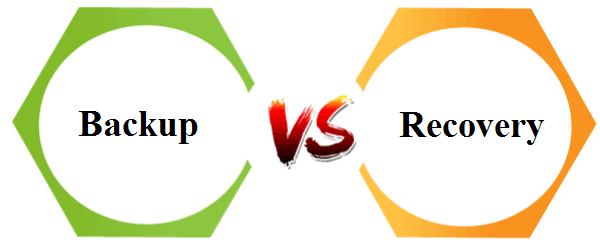Key differences between Backup and Recovery

The key differences between backup and recovery lie in their purpose, functionality, and processes:
-
Purpose:
- Backup: The primary purpose of backup is to create copies of data, systems, or applications for the purpose of protection against data loss, corruption, or accidental deletion. Backups serve as a preventative measure, allowing organizations to restore data and systems to a previous state in the event of an incident.
- Recovery: Recovery, on the other hand, refers to the process of restoring data, systems, or applications to a functional state after a disruptive event or loss of functionality. The goal of recovery is to minimize downtime, recover lost or corrupted data, and restore normal operations as quickly as possible.
-
Functionality:
- Backup: Backup solutions are designed to capture and store copies of data, systems, or applications at specific points in time. This involves creating duplicates of files, databases, configurations, or entire systems and storing them in a secure location, such as local or offsite storage, cloud storage, or tape drives.
- Recovery: Recovery solutions encompass a range of processes and techniques for retrieving and restoring data, systems, or applications from backups or other sources. This may involve restoring data from backups, rebuilding systems from images or snapshots, or recovering lost or corrupted files using specialized tools and procedures.
-
Timing:
- Backup: Backups are typically performed on a regular schedule, such as daily, weekly, or monthly, depending on the organization's backup policies and retention requirements. The frequency of backups may vary based on factors such as data volatility, recovery objectives, and resource constraints.
- Recovery: Recovery is initiated in response to a specific event or incident that has caused data loss, system failure, or disruption of operations. Recovery efforts are undertaken as needed to restore data and systems to a known working state, minimize downtime, and resume normal operations.
-
Outcome:
- Backup: The outcome of a backup process is the creation of duplicate copies of data, systems, or applications, which can be used for recovery purposes in the event of a disaster or data loss incident.
- Recovery: The outcome of a recovery process is the restoration of data, systems, or applications to a functional state following a disruptive event. Successful recovery ensures that critical business functions can resume, data integrity is maintained, and the impact of downtime is minimized.
In summary, backup is the process of creating copies of data for protection, while recovery is the process of restoring data to a functional state after a disruptive event. Backup is a proactive measure aimed at preventing data loss, while recovery is a reactive measure taken in response to incidents or failures. Both backup and recovery are essential components of data management and disaster recovery planning, working together to ensure the availability, integrity, and continuity of critical business operations.
Thank you,
